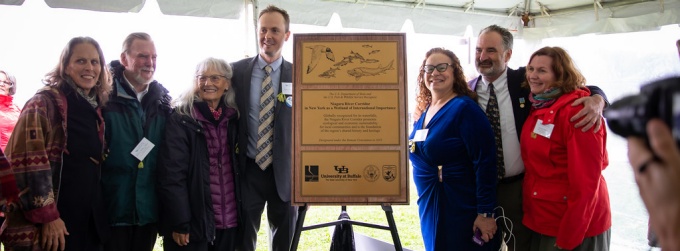
(Right to left) Kerry Mitchell, Niagara River Corridor Ramsar Steering Committee Member; Professor and Dean Robert Shibley, UB School of Architecture and Planning; Lynda Schneekloth, Niagara River Corridor Ramsar Steering Committee Member; Jajean Rose-Burney, Deputy Executive Director of the Western New York Land Conservancy; Professor and Vice Dean Kim Diana Connolly, UB School of Law; Gregory Stevens, Executive Director of the Niagara Greenway Commission; and Jocelyn Baker, Canadian Co-Chair, Niagara River Corridor Ramsar Steering Committee.
Clinic’s work pays off with Niagara River’s global designation as a wetland of international importance
Six years of work by students in UB School of Law’s Environmental Advocacy Clinic - more than 1,450 pro bono hours invested by our student attorneys. And a total of 33 students who helped build the legal and informational foundation – all to celebrate the global significance of Western New York’s mighty Niagara River.
That multi-year effort came to fruition in early October when the river and its corridor were named a wetland of international importance under the Ramsar Convention, an intergovernmental treaty to protect wetland systems worldwide. A designation ceremony held earlier this month on Goat Island in Niagara Falls, N.Y., made it official: The river is now the 40th Ramsar site in the United States, on par with Everglades National Park and the San Francisco Bay.
Professor and Vice Dean Kim Connolly, who teaches the Environmental Advocacy Clinic, says the clinic served as legal counsel to a bi-national Niagara River Ramsar steering committee made up of expert representatives from organizations in both the US and Canada.
“The students, under the supervision of Professor Connolly, were really the lawyers here,” says Ryan McPherson ’02, UB’s chief sustainability officer. “They were the ones who prepped it, did all the research, really did the grunt work.”
View photos from the Niagara River Ramsar Designation Ceremony.
View photos from the program "Learning from the Ramsar Designation of the Niagara River Corridor."
Much of that effort involved the clinic students working with the steering committee to create a comprehensive Ramsar Information Sheet, which showed how the site meets the criteria set forth in the Ramsar convention. The document, which ran to nearly 100 pages, detailed the diverse ecosystem of the Niagara River Corridor: its abundance of noteworthy flora and fauna, its diverse ecological features, and its social and cultural values. The Niagara River, the information sheet noted, “supports at least 338 species of birds, 100 species of fish, 31 species of mammals, 11 species of reptiles, 13 species of amphibians, 12 species of mussels and 231 species of plants.”
In addition, students helped to secure written endorsements for the Ramsar designation from every landowner in the designation area, as well as local, state and federal government endorsements. They also gave multiple presentations over the years in the community, at academic conferences, and at governmental offices.
“The U.S. Fish and Wildlife Service has identified this as the most complex (Ramsar) submission that the United States has ever had,” Connolly says.
“As someone who has visited many Ramsar sites, participated in international conferences, and researched and published about Ramsar, I can confirm that the Niagara River Corridor is an outstanding site,” says Connolly. “It is a superb example of importance and excellence. This designation is a win-win-win – for the ecosystem itself, for the people and communities who rely on it, and for the non-humans who depend on its preservation. The nomination could not have happened without the excellent work of our student attorneys.”
The designation is expected to spark interest in ecotourism for the area, beyond the 8 million visitors annually who come to see the iconic waterfall.
U.S. Rep. Brian Higgins, D-Buffalo, was among the officials at the designation ceremony. “Anyone who has spent time around the Niagara River Corridor understands it is arguably one of the most incredible places in the world,” Higgins says. “This Ramsar designation formally solidifies, and highlights for the world, the Niagara River Corridor’s standing as a site of international significance. I commend the local stewards who sought out and secured this designation.”

